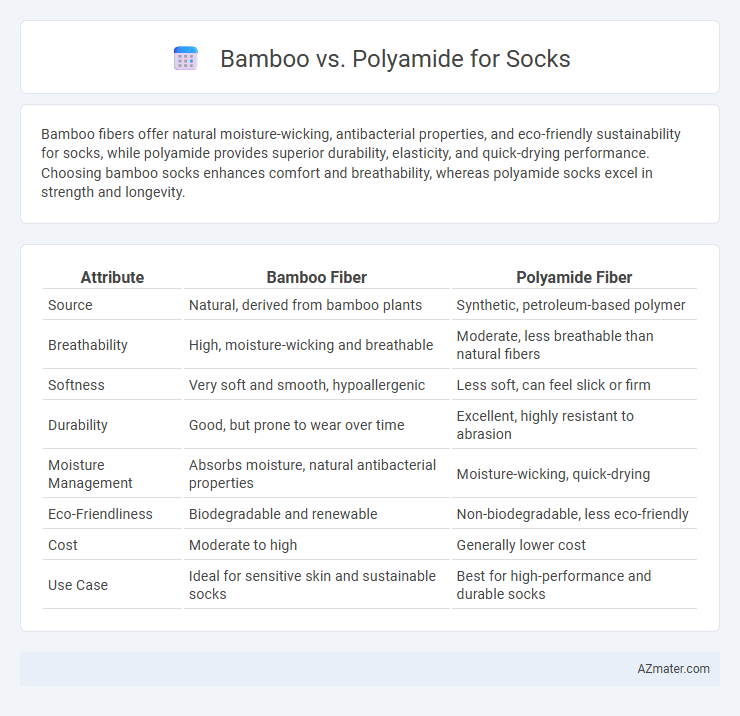Bamboo fibers offer natural moisture-wicking, antibacterial properties, and eco-friendly sustainability for socks, while polyamide provides superior durability, elasticity, and quick-drying performance. Choosing bamboo socks enhances comfort and breathability, whereas polyamide socks excel in strength and longevity.
Table of Comparison
| Attribute | Bamboo Fiber | Polyamide Fiber |
|---|---|---|
| Source | Natural, derived from bamboo plants | Synthetic, petroleum-based polymer |
| Breathability | High, moisture-wicking and breathable | Moderate, less breathable than natural fibers |
| Softness | Very soft and smooth, hypoallergenic | Less soft, can feel slick or firm |
| Durability | Good, but prone to wear over time | Excellent, highly resistant to abrasion |
| Moisture Management | Absorbs moisture, natural antibacterial properties | Moisture-wicking, quick-drying |
| Eco-Friendliness | Biodegradable and renewable | Non-biodegradable, less eco-friendly |
| Cost | Moderate to high | Generally lower cost |
| Use Case | Ideal for sensitive skin and sustainable socks | Best for high-performance and durable socks |
Introduction to Bamboo and Polyamide Socks
Bamboo socks are crafted from bamboo fiber, known for its natural antibacterial properties, moisture-wicking ability, and eco-friendly sustainability, making them ideal for sensitive skin and active lifestyles. Polyamide socks, made from synthetic polyamide fibers, offer exceptional durability, elasticity, and moisture resistance, ensuring long-lasting comfort and shape retention. Both materials cater to different needs, with bamboo emphasizing breathability and environmental benefits, while polyamide focuses on performance and resilience.
Material Composition and Origin
Bamboo socks are primarily made from bamboo viscose, a biodegradable fiber derived from bamboo pulp known for its natural moisture-wicking and antibacterial properties. Polyamide socks consist of synthetic polyamide fibers, commonly known as nylon, produced through petrochemical processes offering high durability and elasticity. Bamboo originates from sustainable grass plants mostly grown in Asia, while polyamide is a petroleum-based textile manufactured predominantly in industrial settings worldwide.
Comfort and Softness Comparison
Bamboo fiber socks offer superior softness and breathability due to their natural moisture-wicking properties and hypoallergenic nature, making them ideal for sensitive skin. Polyamide socks provide durability and elasticity but tend to be less breathable and softer compared to bamboo, potentially causing discomfort during extended wear. For maximum comfort and softness, bamboo socks outperform polyamide by combining natural fiber benefits with excellent cushioning and temperature regulation.
Moisture-Wicking and Breathability
Bamboo fibers offer superior moisture-wicking capabilities by naturally absorbing and evaporating sweat faster than polyamide, keeping feet dry and comfortable during prolonged wear. Bamboo's breathable structure allows enhanced air circulation, reducing heat buildup and odor, while polyamide, a synthetic material, tends to trap heat and moisture despite its durability. For socks, bamboo provides a more breathable and moisture-wicking option, ideal for active use and sensitive skin.
Odor Control and Antibacterial Properties
Bamboo fibers naturally possess antimicrobial properties that inhibit odor-causing bacteria, making them an excellent choice for odor control in socks. Polyamide, while durable and moisture-wicking, lacks intrinsic antibacterial qualities, often requiring chemical treatments to achieve similar odor resistance. Therefore, bamboo socks provide superior odor control and antibacterial benefits compared to standard polyamide socks.
Durability and Longevity
Bamboo socks offer natural antibacterial properties and moisture-wicking benefits, but their durability may be lower compared to polyamide socks, which provide exceptional strength and resistance to wear and tear. Polyamide fibers enhance sock longevity by maintaining shape and preventing pilling, making them ideal for high-performance or heavy-use conditions. Choosing polyamide blends often results in longer-lasting socks that withstand frequent washing and extended use without significant degradation.
Environmental Impact and Sustainability
Bamboo socks offer superior environmental benefits due to bamboo's rapid growth and minimal need for pesticides or fertilizers, making it a renewable and biodegradable resource with a low carbon footprint. Polyamide socks, derived from petroleum-based synthetic fibers, contribute significantly to microplastic pollution and consume more energy and non-renewable resources in production. Choosing bamboo socks supports sustainability efforts by reducing waste and environmental degradation compared to the non-biodegradable nature and higher ecological impact of polyamide materials.
Skin Sensitivity and Allergen Risks
Bamboo fibers are naturally hypoallergenic and antimicrobial, making them ideal for sensitive skin by minimizing irritation and reducing allergen risks. Polyamide, a synthetic material, may cause discomfort or allergic reactions in individuals with sensitive skin due to chemical treatments and reduced breathability. Choosing bamboo socks supports enhanced skin health by promoting moisture-wicking and maintaining a gentle, irritation-free environment.
Cost and Value for Money
Bamboo socks generally offer better value for money due to their natural antibacterial properties, moisture-wicking abilities, and eco-friendly production, despite a slightly higher initial cost compared to polyamide socks. Polyamide, a synthetic material, tends to be cheaper upfront but may lack breathability and comfort, potentially reducing long-term durability and wear satisfaction. Choosing bamboo socks often results in greater overall cost efficiency through enhanced comfort and longevity.
Choosing the Best Material for Your Needs
Bamboo socks offer superior moisture-wicking and natural antibacterial properties, making them ideal for sensitive skin and active lifestyles. Polyamide socks provide excellent durability, elasticity, and resilience, suitable for high-performance and everyday wear. Choosing between bamboo and polyamide depends on whether comfort and breathability or strength and longevity are your priority in sock material.

Infographic: Bamboo vs Polyamide for Sock
 azmater.com
azmater.com